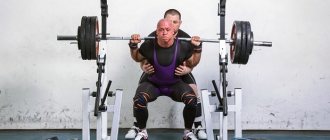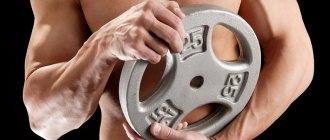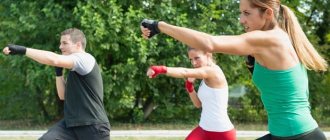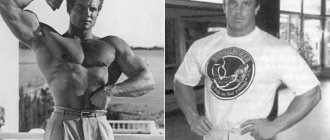19 February 2020 Admin Home page » Plyometrics
When moving on to exercises, in order to avoid serious mistakes, I strongly recommend reading the benefits of plyometrics and its main rules .
In the initial stages, you need to do 3 workouts a week for 30 minutes, since the loads are less and the classes are shorter, then when you reach high intensity, exercise 2 times a week for 45-60 minutes.
When performing plyometric exercises, we do not hold our breath; exhale when exerting effort, inhale when relaxing, that is, when jumping, exhale, when landing, inhale.
THE GOLDEN RULE OF PLYOMETRICS is force multiplied by speed, that is, the faster and stronger the jump or jump, the greater the effectiveness of the training.
» All exercises are performed for a minute or 20-30 repetitions;; » There are no pauses between repetitions of exercises; » Between exercises, rest for a maximum of 10 seconds; » Between repeating the complex or alternating them, rest for 2-3 minutes; “When you rest, do not fall on the floor, but walk, breathe deeply and drink water.
Subscribe to groups on social networks (VKontakte, Odnoklassniki, Facebook, Twitter), it’s very easy to find us, just write Bomb body in the search for the desired group!
What is plyometric training and what makes it special?
Plyometrics is a technique aimed at performing exercises with your own weight or light weights, based on jumping movements. They are performed at an intense pace with explosive (shock) force. A classic example is a depth jump from a height (usually 50–70 cm) with a quick jump up.
Plyometric exercises were originally developed for professional athletes to enhance their physical abilities. The author of the methodology is Yuri Verkhoshansky, head of the department of theory and methodology of sports training at the All-Union Institute of Physical Culture. He was tasked with improving the performance of the USSR athletics team for the upcoming Summer Olympics in Moscow.
From then until now, plyometric techniques have been used to train boxers, sprinters, skiers, and weightlifters. They are popular in crossfit, workout and parkour.
The peculiarity of the technique is to stimulate muscles in three different states, each of which lasts a minimally long time:
- lengthening - eccentric contraction (at the moment of landing during a depth jump);
- increased muscle tension without movement - isometric or static load (while standing motionless on the surface);
- shortening - concentric contraction of a muscle under the influence of a load (for example, when jumping up).
An exercise is considered plyometric if it is performed as quickly as possible (0.1–0.3 seconds), with explosive force.
Research results have proven that plyometric training is the most effective among all existing methods for increasing the strength and functional ability of muscles. This type of exercise allows you to use the maximum number of muscle groups.
Plyometrics in fitness
Since plyometric movements are now popular not only among professional athletes, but also among fitness enthusiasts, let's look at another example to help understand the essence of the technique. Let's look at a popular fitness trend - step aerobics, during which you need to jump on a special platform many times.
First, the girl stands on the floor, then with a sharp movement she pushes off the surface and jumps onto the platform. Muscle shortening occurs, in other words, concentric contraction. For a fraction of a second, the practitioner is on the platform itself - this is an isometric contraction, i.e., absence of movement.
When jumping from a step to the floor, a muscle stretch occurs, officially called an eccentric contraction.
At first glance, the exercise seems clear and simple, but since it must be performed extremely quickly, observing the correct technique, it is quite difficult for an unprepared person to complete it.
In fact, there are different opinions on whether plyometrics are effective for weight loss. But do not forget that it was not invented as an effective method of quickly losing weight, but to help achieve excellent athletic performance.
Advantages and disadvantages of exercise
In addition to the fact that plyometrics can significantly increase muscle strength and endurance, other positive changes occur when performing exercises with explosive strength:
- the speed of all metabolic reactions in the body increases;
- coordination of movements and dexterity improves;
- strengthens the muscles and tendons of the legs;
- the reaction speed increases.
Plyometric training provokes increased secretion of anabolic hormones in the body. This promotes faster recovery after strength training, muscle gain and weight loss. Up to 600 kcal is burned in one session.
Thus, plyometric exercises can be successfully used instead of iron and cardio equipment to create a beautiful, sculpted body.
Another advantage is that you can train without special equipment, at home, with only a small free space (4–6 m2). The duration of the lesson is no more than 45 minutes (excluding warm-up and stretching time).
Despite all the advantages, plyometrics also has disadvantages.
- This technique is designed for professional athletes or amateurs with a fairly high level of physical fitness. It is better for beginners to take their first steps in sports using other types of physical activity.
- If performed incorrectly, you can get injured.
- Plyometrics are contraindicated in case of varicose veins and obesity above degree 1.
- Due to the increased load on joints and tendons, jumping exercises should not be performed by athletes with musculoskeletal diseases, as well as older people.
Despite its effectiveness, the set of plyometric exercises is monotonous and becomes boring over time.
Who shouldn't jump
Plyometric training was originally created for athletes from a team that participated in international competitions. Therefore, those who are planning to master explosive jumps should know that jumping ropes require good physical shape.
Remember!
If at the start of training you are overweight over 10 kg, pay attention to proper nutrition and cardio training to lose those extra pounds.
Jumping vigorously is not recommended if you have:
- phlebeurysm;
- joint diseases (special attention to the knees!);
- lung problems;
- obesity;
- chronic motor coordination disorders;
- poor vision;
- heart diseases.
Features of training: what do you pay attention to when performing exercises?
Plyometric training involves performing several approaches (blocks), each of which contains one exercise. It is performed several times in a row with minimal rest. There is a short break between approaches.
In order for training to be effective for functional development and not harm health, several rules must be followed:
- Be sure to warm up before the main part of the lesson.
- Perform each repetition of the exercise at the same pace.
- One block should not take more than 60 seconds to complete.
- The rest between blocks should not be too long (1.5–2 minutes). This allows you to keep your heart rate high and your muscles warm.
- Always perform effort while exhaling, relaxation while inhaling.
- When jumping, be sure to fully straighten your legs, but to reduce the risk of joint injury when landing, you need to bend your knees, pointing them outward.
- The surface on which the training is carried out should not be too hard (ideally earth, grass or rubber coating). It is advisable to avoid concrete and asphalt.
All exercises included in the training complex must be performed as quickly as possible, but first you need to master the technique at a slow pace. The speed and time spent on completing one block must be increased gradually.
Plyometric exercises
We offer you a selection of the most popular plyometric exercises without equipment that will help you build an effective, high-quality workout. All plyometric exercises are conditionally divided into 3 difficulty groups. As you understand, the division is quite arbitrary, since the complexity of the exercises is largely determined individually.
Low difficulty plyometric exercises
1. Jumping Jack
2. Jumps with leg extensions in the plank (Plank Jack)
3. Running with knee lifts (High Knees)
4. Skater
5. Skier (Ski Jump)
6. Mountain Climbers
Moderate plyometric exercises
7. Lunge Jump
8. Plank Tuck In Out
9. Jumping 180 degrees (180° Jump)
10. Front Kick
11. Running in a table position (Crab Kicks)
12. Squat Jump
Advanced plyometric exercises
13. Tuck Jump
14. Push-up with Clap
15. Burpee
16. X-jump
17. Kicks to the buttocks in plank (Donkey Kicks)
Gif pictures in the article are used from the video 44 Best Plyometric Exercises (Veva YouTube channel)
Plyometric Training Tips
- Before moving on to creating plyometric training programs from the proposed exercises, let us draw your attention to the recommendations that must be followed for maximum effectiveness from plyometrics.
- The workout should always begin with a warm-up (7-10 minutes) and end with a cool-down and stretching (5-7 minutes). Never start exercising without warming up, as this can lead to injury.
- The duration of plyometric training should be no more than 60 minutes, including warm-up and cool-down. If you are just starting to do plyometrics, limit your workout to 15-20 minutes, gradually increasing the duration of the session.
- Plyo workouts are fast-paced, but you must perform the exercises thoughtfully, with full concentration and proper technique to avoid injury. Correct form is always more important than the number of repetitions!
- As a rule, plyometric training is based on a circuit training system and is based on repeating exercises in several approaches. Perform each exercise for 20-45 seconds, resting 10-30 seconds between exercises. Each circle should have 4-8 repetitions, rest between circles for 1.5-2 minutes. You will find ready-made training programs below.
- If you are focused on developing explosive muscle strength, then do plyometric training 3 times a week. If you just want to improve your shape, tone your body and enhance the anabolic effect, then it is enough to do plyometrics 2 times a week, combining it with strength training. Rest between plyo workouts should be at least 48 hours.
- To practice plyometric exercises, you should already have at least minimal training experience. If you have not been involved in fitness for a long time, then it is better to start losing weight by walking on a treadmill or by walking at home using a video.
- At first, try to do plyometric training only with your own body weight without using additional equipment (weights, benches and boxes). If necessary, it is better to start using them no earlier than after a month of regular exercise. By the way, the use of a medicine ball in plyometric training is very popular.
- When performing plyometric training, it is not the amplitude of the exercises that is important, but the speed of execution. For example, when performing a Squat Jump, it is important not to squat as deeply as possible, but to jump out as quickly as possible.
- Do not perform plyometric exercises on a shock-absorbing (non-hard) surface.
- When regularly performing plyometric training, it is better to use knee and ankle braces. This will help reduce the impact on your joints, although it will not protect 100%.
- It is advisable not to eat 1.5-2 hours before the start of the jumping program, otherwise this may cause indigestion.
- Plyometric exercises will be equally effective for both men and women.
- Always do plyometric training in shoes with non-slip soles.
See also:
- Top 20 Best Men's Fitness Shoes
- Top 20 Best Women's Fitness Shoes
The effectiveness of this program
Plyometric exercises are a great addition to any sport. If you alternate them with going to the gym or morning jogging, positive dynamics in changes in body composition will appear faster.
When using this technique, not only changes occur in muscle fibers, but also in the nervous system - the speed of operation of motor neurons increases. Plyometric training primes muscle fibers and the central nervous system to produce the fastest, most powerful force possible in a short period of time.
If you include plyometric exercises in your training plan, strength endurance develops and working with heavy weights becomes more effective. Such training helps overcome the plateau effect in weight loss and stagnation in muscle mass gain.
Methodology of Yuri Verkhoshansky
For the first time, this explosive muscle power was noticed back in the 50s of the nineteenth century by Yuri Verkhoshansky, a talented coach, author of articles and textbooks on sports training methods.
The author's method of training, developed by Professor Yu. Verkhoshansky, when the magnitude of the brain-muscle impulse is trained, allowed the athletes of the USSR national team to enhance speed and strength characteristics and achieve excellent results in competitions.
The method of Professor Yu. Verkhoshansky turned out to be so effective that it became widespread not only in Russia, but throughout the world.
But the now popular name - plyometrics - was invented by an American trainer.
Approximate example of a training complex
The basis of the plyometric training complex consists of several exercises, which can be performed consistently to work all muscle groups. These include:
- jumps: high (on a box or platform), long and deep from a height;
- push-ups from the floor with arms lifted off;
- pull-ups on the horizontal bar;
- throwing objects to each other (for example, a gymnastic ball - medicine ball).
Below is an approximate complex that is recommended to be performed 3 times a week.
You need to start your workout by stretching your entire body: from neck to feet. It is recommended to start the main part with adducting exercises; together with a warm-up, they will perfectly warm up the body and prepare it for further stress:
- Touching the floor and rising onto your toes. Stand straight, feet shoulder-width apart, arms extended upward. Without bending your knees, bend forward until your fingers touch the floor. Return to the starting position, rise on your toes.
- Burpee. From a straight stance, perform a squat, placing your palms in front of you on the floor. Quickly move your legs back to be in a prone position. Return to the squat position, rise up (without jumping) and stand on your toes, raising your arms up.
Next, perform a plyometric exercise for the legs and buttocks:
- Jumping on a support. Bend your knees, push off strongly from the surface and jump onto the platform (box), stay at the top for a moment, and jump down.
- “Frog” is a simplified version of the previous exercise - jumping up in place. From a half-squat, push off with your feet and jump as high as possible, straightening your legs completely. Land in the starting position. The hands are not involved in the movement; they are behind the head.
- Jumping lunges. Make a classic lunge forward (the angle at the knee of the supporting leg is 90 0). Jump up, changing the position of your legs with a quick movement, and land softly.
To make it more difficult, you can use a small weight - take dumbbells in your hands or wear a weighted vest.
Explosive muscle power
Imagine a spring that you are trying to stretch. No matter how hard you try, the spring comes back.
The same principle applies if plyometric exercises . The fashionable term means jumps familiar from childhood.
By jumping, a person uses the natural ability of muscle tissue to stretch and then contract.
Remember jumping over puddles in the rain. The faster and harder you push off the ground, the more likely you are to jump over the puddle.











